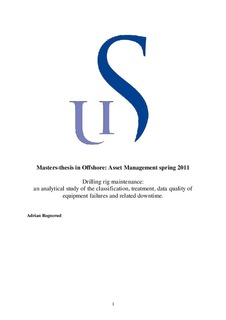| dc.contributor.author | Rognerud, Adrian | |
| dc.date.accessioned | 2013-07-02T11:27:54Z | |
| dc.date.available | 2013-07-02T11:27:54Z | |
| dc.date.issued | 2011 | |
| dc.identifier.citation | Konf. til juni 2013 | no_NO |
| dc.identifier.uri | http://hdl.handle.net/11250/183050 | |
| dc.description | Master's thesis in Offshore technology | no_NO |
| dc.description.abstract | The aim of this thesis is to improve the way failures caused by insufficient maintenance are being managed and reported on drilling rigs and thereby reducing the overall downtime and related cost for the rigs.
By looking into the quality of reports for critical and non-critical failures, identifying the potential consequences of non-critical failures and identifying downtime trends and possible reasons for these we will try to make suggestions on how to improve the maintenance management.
The downtime caused by insufficient maintenance was found to be low compared to other causes, with 3rd party suppliers being the cause of a large percentage of the downtime.
After introducing first line maintenance in 2006 there is a significant decrease in the number of downtime events. The downtime is however not decreasing with the reduction of events; this is most likely because the downtime is dominated by large single events. These large single downtime events have not been reduced as successfully as the smaller with the introduction of first line maintenance. Further studies of these large downtime events should be done in order to better prevent them from occurring again in the future.
Most of the downtime was found to be caused be a small selection of equipment groups, with the main contributor being the Rotary table, top drive and associated equipment group.
Using planned downtime has shown to reduce not only the unplanned downtime, but also the overall downtime of the rig.
When studying the effect of major overhauls on two different rigs we found that it preserved a very low downtime and need for maintenance for one rig and significantly lowered both for the other rig.
The quality of the reports was studied against existing guidelines and requirements as well as the requirements during the work of this thesis. Two of the databases were found to contain data of good quality, while the third in large parts not only failed to meet the requirements in this thesis, but also the existing internal requirements of NADL. To use the databases to find any hidden downtime was found to be difficult, if not impossible. A different set of criteria’s in the reports have been proposed in this thesis in order to make this possible. To increase the overall quality of the reports it was found that improved communication between receiver and sender most likely will give good results. | no_NO |
| dc.language.iso | eng | no_NO |
| dc.publisher | University of Stavanger, Norway | no_NO |
| dc.relation.ispartofseries | Masteroppgave/UIS-TN-IKM/2011; | |
| dc.subject | offshore teknologi | no_NO |
| dc.subject | driftledelse | no_NO |
| dc.subject | drilling rig | no_NO |
| dc.subject | maintenance | no_NO |
| dc.subject | data quality | no_NO |
| dc.subject | downtime | no_NO |
| dc.subject | equipment failure | no_NO |
| dc.subject | failure classification | no_NO |
| dc.title | Drilling rig maintenance: an analytical study of the classification, treatment, data quality of equipment failures and related downtime | no_NO |
| dc.type | Master thesis | no_NO |
| dc.subject.nsi | VDP::Technology: 500::Materials science and engineering: 520 | no_NO |
